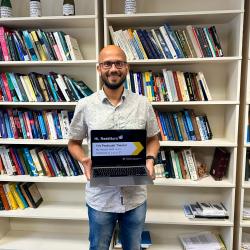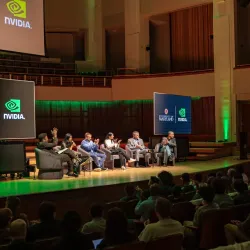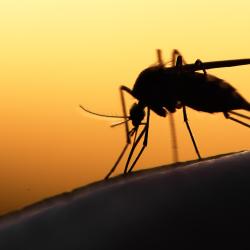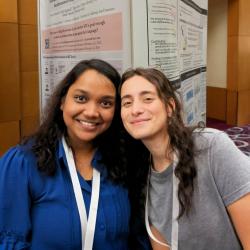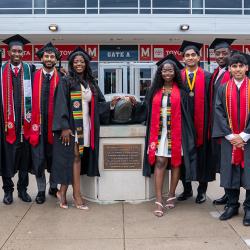Entomology Associate Professor Anahí Espíndola Answers Questions About Pollinators
The College of Computer, Mathematical, and Natural Sciences hosted a Reddit Ask-Me-Anything spotlighting pollinator research.

University of Maryland Entomology Associate Professor Anahí Espíndola participated in an Ask-Me-Anything (AMA) user-led discussion on Reddit to answer questions about pollinators on June 16, 2025.
Espíndola’s research connects ecology and evolution to understand the effect of the biotic and abiotic environment on individual species, species communities and inter-species interactions (with a slight preference for pollination). A significant part of her focus is now on the Pan-American plant genus Calceolaria and its oil bees of genera Chalepogenus and Centris.
This Reddit AMA has been edited for length and clarity.
What is the most surprising pollinator-plant interaction that you have encountered?
A very cool specialized pollination interaction is with Araceae plants. In many of these plants, the inflorescence (the "flower") produces heat to attract pollinators and to better release volatiles that often mimic the laying sites of the insects being attracted. In many of these cases, the insects are completely exploited by the plant and receive no rewards for their pollination services. (In some cases, though, pollinators may benefit a bit from the heat because often these plants flower and produce heat during times of the year when the air temperature is relatively low.)
I've heard that no one knows what pollinates vanilla orchids, so vanilla growers are forced to hand-pollinate. Is this true?
Orchids originated from Central and South America. Today, vanilla is produced mostly in Madagascar and other parts of the world. When people took vanilla plants from Central and South America and started growing them elsewhere, those Central and South American bees weren't there to pollinate them. In those regions, vanilla is hand-pollinated so that vanilla beans can be produced.
There was a recent study conducted in Mexico and Peru to figure out who pollinates wild vanilla species. In Mexico, they couldn't observe any pollination events, which they think was because they were looking at a very rare plant species, so plant wouldn't be found often by pollinators. But in Peru, they were looking at a more common vanilla plant, and they observed pollination by a Euglossine, an orchid bee. These bees generally collect scents from orchids; while the researchers didn't see them collecting scents from vanilla, they did effectively pollinate them.
Lastly, orchids are often not pollinated quickly. In the case of vanilla, researchers would need to observe plants for a very long time (as they did in the study mentioned above) to be able to observe effective pollination. If you'd like to learn more about the vanilla plant, you can read this blog article I wrote a few years ago.
Was there anything specific that drew you to a research focus on calceolaria?
During my Ph.D., I visited family and friends in Argentina and went hiking in the Andes. As I was hiking, I saw these calceolaria plants and I could not stop thinking about them; I decided I wanted to know everything about them. I decided this would be a great system to try to understand the effect of interactions and the abiotic environment on the evolution of groups of organisms (in this case, calceolaria).
There were some challenges to understanding the evolutionary history of the plant, and I thought that I could contribute my expertise. I went on to connect with researchers from South America who were working on calceolaria and started building a research line to advance calceolaria knowledge. We are actually about to publish a resolved phylogeny for calceolaria—stay tuned!
Do you have any advice for people wanting to engage with entomology and support biodiversity without necessarily going into that field of work?
One great way is to learn about entomology, in particular about aspects that may have a direct impact on your life. This may mean going to talks, participating in virtual events such as this one, and/or becoming a master naturalist.
If you want to engage in biodiversity conservation, you can start at home. Maybe you have spaces that need an increase in biodiversity. Maybe you can reconsider your use of pesticides and the types of products you consume/use. Maybe you can lead actions with your neighbors and participate in city/municipal, county and state groups and boards, where many decisions that may be relevant to these topics are made.
How is global warming impacting the behavior of pollinators, and do you see any evidence of species evolution in response to warmer temperatures?
Global warming is impacting pollinators in different ways. To start off, changes in climatic conditions mean these pollinators may need to move to different regions to find their ideal climate. If pollinators disperse to new regions, the plants they depend on may not be present there, which can have negative impacts on the population. If they are not able to disperse, maybe because there is not enough habitat for them to move to, their populations will become smaller and the likelihood of extinction increases.
Another way climate change is affecting insects in general is that changes in winter temperatures can lead to varied life cycles—in particular, earlier emergence from winter hibernation. In some species, this can also negatively affect the pollinators' ability to survive; when they emerge, their host plants may not be around for them to feed on. This study shows how this is happening to the Baltimore checkerspots.
As for pollinators that have evolved as a response to climate change, I am not aware of any studies that have strongly demonstrated pollinators' adaptation to climatic conditions. These analyses take a really long time to complete, and it is even harder when one is working on a wild species that one cannot easily manipulate.
How is the future of humanity looking now that insect populations, including pollinators, are largely decimated by our actions? What will happen to our crops, and is there anything we can do to prevent ecosystem collapse?
Yes, insect populations and biodiversity are declining at a very worrisome rate, and this will impact our ability to feed ourselves, live in healthy environments and leave resources that can sustain our kids, grandkids and beyond. Biodiversity helps us in many ways, including food production (through pollination, pest control, nutrient cycling) and the physical protection of infrastructure (e.g., forests in mountainous areas that retain soil and water and prevent landslides and floods). Biodiversity also plays a key role in sustaining our cultures, because every culture is connected to the natural environment through stories, history and memories. If we lose our connection to that environment, we're losing part of who we are.
So, what should we do? Mitigate and reduce climate change, promote biodiversity, reduce the use of chemicals when not needed, increase habitat (which can mean many things, including smarter use of our land), fund research that helps find these solutions, and advocate for policies that allow these solutions to be implemented and used. In 2021, the Intergovernmental Panel on Climate Change and Intergovernmental Science-Policy Platform on Biodiversity and Ecosystem Services produced a very good joint report that provides a lot of insights on how we can both reduce climate change and improve biodiversity through actions that promote both. Section 7 of this report shares guidelines that can be applied to our everyday lives, as well as recommendations for policy-making, governance and communities.
What meaningful actions can a regular person like me take to support insect conservation?
Increase biodiversity in whatever space you're in. For example, plant many different (ideally native) plants in your yard. Provide spaces where pollinators can nest. We usually think about supporting pollinators by planting more flowers, which offer food, but pollinators need places to live as well. By providing nesting sites, we can support them that way, too. Pollinator nesting sites vary by species, but can include branches, twigs, open soil, rocks, crevices, and, of course, lots of different plants.
Another great way to support pollinators and insects is to strongly reduce—and ideally, avoid—the use of pesticides. The good news is that by increasing biodiversity as mentioned above, one shouldn't need pesticides for most common uses because biodiversity increases pest control and can reduce the occurrence of diseases in a green space.
We are all members of this society, and we all have the power to work with each other to have a larger impact. Talk to your representatives and your neighbors, and make sure that these actions are also implemented at a larger scale.
Last but certainly not least, learn about pollination and biodiversity. iNaturalist is a great resource to learn about the natural world. You can interact with this resource through any browser or through the app. This will connect you with a global network of naturalists who will help you learn about the natural world around you.
How do nectar-accessed-but-no-pollination-occurred events impact the ecology of a niche and broader evolutionary responses from insects and plants?
Generally, one can think about plant-pollinator interactions as interactions with an exchange of services and products. This exchange, in the case of mutualistic pollination interactions, is balanced, meaning that the benefit to the two interacting species has to be positive overall. If there is exploitation or cheating, the balance of the interaction changes; and if this happens consistently and over many generations, that mutualistic interaction can transition into a parasitic interaction. In general, once mutualistic pollination interactions are established in evolutionary lineages, they rarely transition to parasitic interactions.
If you're interested in learning more about this, you can take a look at Patricia Willmer's "Pollination and Floral Ecology." In this book, she describes a lot of the main adaptations of plants and pollinators to the pollination interactions and gives a general introduction to ecological and evolutionary thinking on pollination.
Could you explain how machine learning fits into the context of your work?
The type of machine learning (ML) that we do is perhaps different from what the general population thinks about when they think of artificial intelligence (e.g., ChatGPT, DeepThought). I use machine learning to extract information that exists in biodiversity databases such as the Global Biodiversity Information Facility to identify trends that can assist in making predictions. Those predictions can relate to the needs for conservation of certain species, which can be used by decision makers to establish structures to formally evaluate species potentially in need of conservation. Another way we can use this information is the identification of cryptic diversity (i.e., species that we may not know exist until we study them).
Although none of these machine learning methods aim to replace human work, they all assist researchers and conservation agents in prioritizing particular species to further study, in a world where funds and expertise are limited. Here are some examples of how I've used machine learning in recent published work:
- Predicting plant conservation priorities on a global scale
- Global Conservation Prioritisation Approach Provides Credible Results at a Regional Scale
- Identifying cryptic diversity with predictive phylogeography
Does the proliferation of Apis mellifera significantly threaten other pollinators like other bees, wasps, flies, bats and birds? If so, what can we humans do to balance the scales?
In most parts of the world, Apis mellifera is a non-native bee reared to produce products for human use and, in some cases, provide crop pollination. Because the honeybee is very efficient and fast in its collection of pollen and nectar, when the native bees arrive to a flower, they can end up with little to no rewards. Sometimes, honeybees very protective of the flowers they are visiting and compete directly with other pollinators, especially when they are smaller. They'll even push them or chase them away from the flowers. Another issue that has been observed in honeybees is that, depending on how the beekeeping is done, they can spread diseases to other flower visitors.
All of this can lead to a reduction in the populations of other native bees and pollinators. This is not to say that one should never have honeybees. However, if your goal is to protect biodiversity and bees in general, getting honeybees is not going to accomplish that. That said, if one is committed to honey production and has the ability and time to properly care for beehives, they should certainly take on that project.
Should I buy organic produce if I want to support a healthier biosphere?
Organic produce is produce that has gone through a certification process that ensures that the production system minimizes the ecological impact as much as possible. For example, there is often a focus on soil health, reduced use of synthetic pesticides and antibiotics, restriction on the number of animals that can be reared in a certain area, etc. If one is consuming organic produce, one is supporting those general production practices. That said, a producer or a farm that is not certified organic can still be following these guidelines without the certification, and even some organic farmers may be allowed sometimes to use particular pesticides or other practices not otherwise considered organic-friendly. (This can be due to a particular disease outbreak or some other extreme event.)
The best way to go about thinking about this is to always try to get seasonal products that are grown under conditions that are ecologically friendly, which you can learn about if you talk to producers. For example, at the farmers market!
Is there a reason some pollinators have specific preferences?
Pollinators are often specialized to some extent on the plants they use, because those plants often have chemical and physical characteristics that make their resources exploitable. This may mean that a pollinator will only visit flowers that have shapes and sizes that they can actually manipulate or that have nectar that they can physically reach and absorb. The pollen a plant produces is also often protected by the plant with physical structures and even chemical materials that make it hard to digest for many insects, so pollinators will also become specialized in the digestion of certain types of pollen that only come from certain types of plants.
What are some of the biggest challenges you are facing in your field currently?
The active current attacks on the U.S. research system and the lack of trust and understanding of science in the general public. While the former is something I have very little power over, for the latter, I think that the role of scientists is to make sure that this changes. I think that all scientists have a passion for what they do, but sometimes they have trouble communicating the complexity of their work, which makes their work inaccessible and misunderstood.
Which unsolved problem/mystery about pollination you find very interesting?
I’d like to better understand how levels of specialization in pollination (or other) interactions affect the evolutionary trajectories of interacting species—for example, how being more or less specialized makes you more or less “sensitive” to going extinct, or “protects” you from extinction. In the lab, we’re working on these topics from different angles, but this is still an unanswered question that I think can open many opportunities, both in the way we think and understand biodiversity and the ways we can use this knowledge to make better conservation decisions.



